The Stranger, directed by Orson Welles and presented in the accompanying video presentation of the classic, is an essential film noir movie that occupies a peculiar place in the history of American cinema. It is both a tight thriller about the hunt for a fugitive war criminal and an early Hollywood effort to confront the horrors of the Holocaust on screen. This article—rooted in the film itself and contemporary documentation—examines the movie as a work of style, ideology, and craft. The analysis honors Orson Welles's creative hand, Edward G. Robinson's dogged investigator, and Loretta Young's torn heroine, while remaining mindful of the production circumstances that shaped what audiences ultimately saw on screen.
Outline
- Introduction to The Stranger as a film noir movie and its historical position
- Synopsis and narrative architecture
- Major themes: identity, guilt, and the banality of evil
- Character analysis: Franz Kindler/Charles Rankin, Mr. Wilson, Mary Longstreet
- Visual style, cinematography, and the clock motif
- Sound, music and editing choices
- Production history and context
- The film’s moral and cultural legacy
- Conclusion: why The Stranger remains essential viewing
Introduction: The Stranger as a Film Noir Movie and Historical Document
The Stranger is often noted as Orson Welles's first excursion into the film noir movie genre, a distinct move for a director whose early work is usually associated with baroque mise-en-scène and complex narrative experimentation. Released in 1946, it arrives at a crossroads: noir aesthetics collide with the immediacy of postwar moral concerns. The film follows Mr. Wilson, an agent of the United Nations War Crimes Commission, as he tracks a high-ranking Nazi fugitive to a quiet Connecticut town. The fugitive, Franz Kindler, has erased almost every trace of his past, leaving only a curious obsession—a mania for clocks—that eventually helps expose him.
From the outset, The Stranger frames itself as more than a simple detective yarn. It stages an investigation into identity and responsibility: who will recognize the past lurking beneath carefully arranged present-day normalcy, and what happens when a community confronts the possibility that one of its own is monstrous? As a film noir movie, It blends suspense conventions—cat-and-mouse tension, moral ambiguity, civic paranoia—with a didactic urgency born of wartime revelations.
Synopsis and Narrative Architecture
The Stranger is structured with a clarity that supports its dual aims: to deliver procedural suspense while leading the audience into an ethical reckoning. The story begins with Mr. Wilson (Edward G. Robinson), an investigator determined to locate Franz Kindler, the architect behind horrific war crimes. He releases Kindler's former associate, Konrad Meinike, hoping the man will lead him to Kindler. When Meinike travels to the United States and disappears before the rendezvous, Wilson follows the trail to Harper, Connecticut.
In Harper, Kindler masquerades as Professor Charles Rankin, an unassuming teacher who becomes engaged to Mary Longstreet, the judge's daughter. The narrative sets up both visible and invisible linkages: Rankin’s clockwork hobby, minute gestures, and an escalating psychological pressure on Mary, whose subconscious recollections become the film’s fragile hinge. Wilson’s task is not simple: he needs to prove that Rankin is Kindler when the only human link is a shaky recollection by Mary that Meinike visited Rankin’s house the day Mary was hanging curtains. Until Mary admits what she saw, Wilson has no admissible evidence.
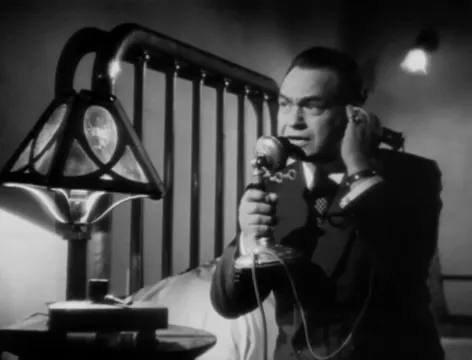
The film methodically escalates tension. An apparently minor detail—an abandoned suitcase left at the bus station—becomes a clue that connects to Meinike and to the town. Red, the Longstreet dog, discovers a grave in the woods and is poisoned to prevent him from exposing the secret. Mary vacillates between love for her husband and an emerging comprehension of his crimes. Wilson uses a daring tactic: he shows Mary documentary footage of concentration camps, an early and shocking instance of Holocaust images in a Hollywood film, to break through denial and force recognition. The climax unfolds in the restored church belfry—an emblematic setting where religious automata and the clockwork motif merge with moral judgment—and results in Kindler's fatal exposure.
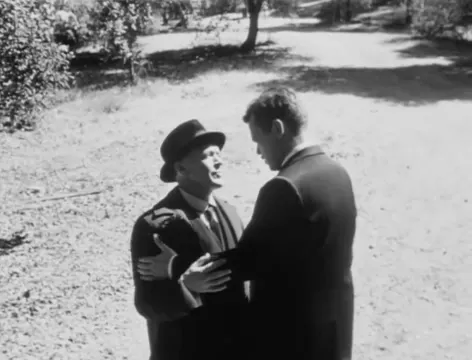
Major Themes: Identity, Guilt, and the Banality of Evil
At its heart, The Stranger is fascinated by how evil can hide behind cultivated normalcy. Franz Kindler's reinvention as Charles Rankin is not merely a matter of forged documents; it's a social camouflage. He embeds himself in respectable institutions—education, marriage, religious ritual—and thereby reveals a terrifying premise: institutions and routines can shelter malevolence.
The film interrogates identity as a manufactured and performative thing. Kindler has destroyed fingerprints, papers, and photographs—every trace that would tie him to his crimes—except for one compulsion that betrays him: a love of clocks. The clock motif is not a gimmick. It becomes a metaphor for the mechanized cruelty of genocide, for the cold regularity with which atrocities were planned, and for the slow accumulation of clues that time inevitably reveals.
Guilt operates on several levels. There is legal guilt, embodied in Wilson's mandate to bring Kindler to justice. There is psychological guilt, visible in Meinike's repentance and in the way Mary is complicit by silence. And there is collective guilt: the film forces a community—and by extension, the viewer—to reckon with the proximity of evil. Rather than offer facile absolution, the film suggests that the work of justice requires vigilance and moral courage.
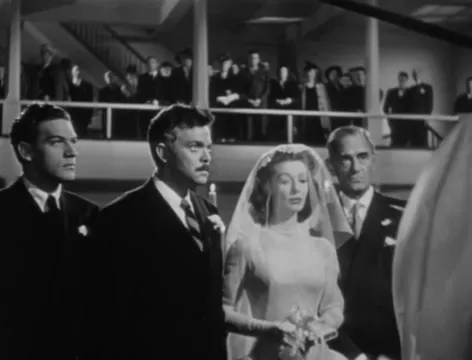
The Banality of Evil and Everyday Respectability
Kindler's daily life as a teacher and his courtship of the judge’s daughter show how ordinary gestures can be weaponized as camouflage. The Stranger is unflinching in showing that evil is not always theatrically monstrous; it can be bureaucratic, methodical, and disturbingly ordinary. This aligns the film with a broader postwar interest in the "banality of evil," later named by Hannah Arendt, and situates it as a film noir movie that probes deeper ethical questions than the average genre entry.
Character Analysis
Franz Kindler / Charles Rankin (Orson Welles)
Welles's portrayal of Kindler/Rankin is a study in control. On the surface, he is the charismatic, urbane teacher—measured, charming, competent at clock repair. Underneath, he is a man who rationalizes atrocity as duty and who maintains a chilling composure. The performance exploits Welles’s physical presence and voice to produce a figure that is both magnetic and repellant. Kindler's insistence on rational order—his clocks, his clean past—reveals a psychological architecture meant to deny moral accountability. Yet the film never permits him complete closure; his past is a ticking force that eventually pierces the façade.
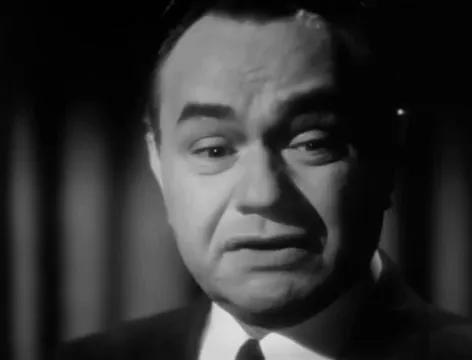
Mr. Wilson (Edward G. Robinson)
Robinson’s Mr. Wilson is the film’s hard-nosed moral anchor. He is pragmatic, relentless, and experienced, a representative of an international legal order grappling with crimes of unprecedented scale. Robinson brings a forensic intensity to the role—Wilson is methodical, almost paternal in his approach to Mary, but his tenderness never blunts his determination to see justice served. As an archetype, Wilson is a reminder that institutional justice can be driven by individual courage.
Mary Longstreet (Loretta Young)
Mary is the film’s moral fulcrum. Her love for Charles makes the revelation of his true identity devastating in a personal sense. Loretta Young renders Mary with warmth and vulnerability; she is not a passive victim but a character caught between loyalty and conscience. The film stages her psychological rupture with sensitivity: her subconscious memories become the key that can either protect or condemn. Mary’s final act—where she dares Kindler to kill her—is a courageous moral assertion that defines her agency. Her transformation from stunned bride to moral witness is central to the film’s emotional and ethical power.
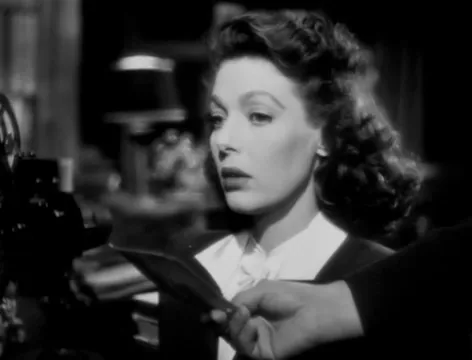
Visual Style, Cinematography, and the Clock Motif
As a film noir movie, The Stranger employs a restrained visual palette relative to more expressionistic noirs, but it uses light and space judiciously to create a pervasive unease. Russell Metty's cinematography is careful: it alternates between sunlit small-town surfaces and claustrophobic interiors where the past conspiratorially presses in. The most striking recurring visual element is the clock and its automata in the church tower.
The clock is photographed as an instrument of inevitability. The camera lingers on gears and figures; these mechanical images become implacable metaphors for the way systems—legal, industrial, ideological—can produce inhuman results when uncoupled from moral restraint. The climactic sequence in the belfry, with its religious automata and sword-bearing figure, stages the ethical resolution in terms of mechanical fate: Kindler’s fall is both poetic and graphically literal, as he is impaled on the moving clock figure. The irony is precise—the instrument that helped him to hide his nature becomes the instrument of his undoing.
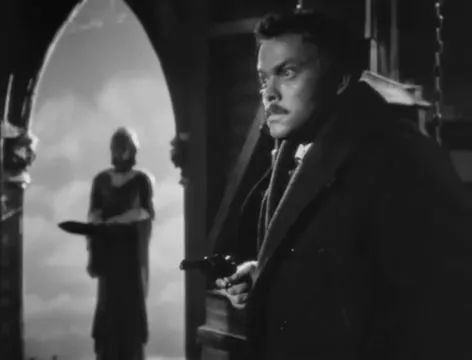
Sound, Music, and Editing
Bronisław Kaper’s score provides an unobtrusive but effective underscore to the film’s tension. It does not announce itself with melodrama but amplifies mood—an approach fitting for a film noir movie that foregrounds psychological dread over action spectacle. The clock’s chimes and mechanical sounds are integrated into the soundscape, becoming a diegetic punctuation that marks narrative moments and psychological beats.
Editing, supervised under studio pressures, was decisive in shaping the film’s final form. Orson Welles worked in a constrained environment; according to production history, editor Ernest J. Nims had broad authority to excise material deemed extraneous. The film’s pace benefits from this discipline: scenes land with clarity, and the narrative avoids indulgent digressions. While critics of Welles may lament the loss of some of his more baroque impulses, the result is a taut, focused thriller that serves both suspense and conscience.
Production History and Context
The Stranger was produced by S. P. Eagle (Sam Spiegel) and distributed by RKO Radio Pictures. It was filmed from late September to November 21, 1945, at Samuel Goldwyn Studios and Universal Studios. Though Orson Welles was given directorial control, his contractual position was constrained: eager to demonstrate he could deliver on time and on budget, Welles accepted terms that limited his later earnings and creative authority. This arrangement affected the film’s texture—Welles’s visual daring is present but modulated by studio oversight.
The film was notable at the time for several reasons. It was Welles’s first completed feature in four years and his first explicit foray into a film noir movie style. It also marked a landmark moment in Hollywood history: The Stranger is the first American studio film to include documentary footage of Nazi concentration camps, incorporated in a narrative context to force moral recognition. This choice made the film historically significant as a mainstream cinematic attempt to visualize the Holocaust's realities for American audiences.
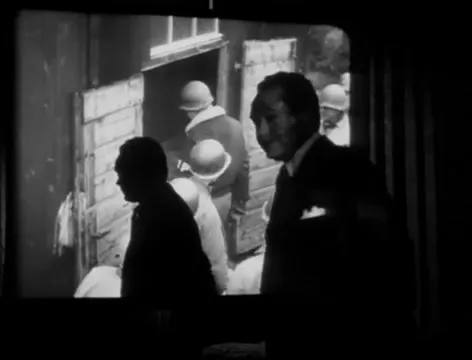
The Film’s Moral and Cultural Legacy
The Stranger’s legacy is multi-layered. As a film noir movie, it demonstrates that noir concerns—paranoia, moral ambiguity, and the fragility of identity—could be marshaled toward a specific ethical interrogation of modern atrocities. Its inclusion of actual concentration camp footage was both courageous and controversial, insisting that audiences confront the material; it resisted the temptation to turn horror into spectacle for sensational ends and instead used documentary imagery to catalyze conscience.
Moreover, the film anticipates postwar debates about justice and memory. Mr. Wilson’s determined pursuit represented a nascent international legal consciousness: the war crimes tribunals and the attempt to make individual responsibility legible under the law. The Stranger dramatizes the difficulty of turning moral outrage into legal proof. The film insists that moral clarity alone does not suffice; evidence, confession, and witness are necessary to translate suspicion into accountability.
Historical Reception and Accolades
The Stranger received mixed critical attention upon release, but it earned noteworthy recognition: it was nominated for the Golden Lion at the 8th Venice International Film Festival, and Victor Trivas received an Academy Award nomination for Best Story. Financially, the production was relatively successful, with box-office returns that outstripped its modest budget. Over time, it has come to be appreciated for its unique combination of genre mechanics and civic seriousness.
- Director: Orson Welles
- Starring: Orson Welles, Edward G. Robinson, Loretta Young
- Music: Bronisław Kaper
- Cinematography: Russell Metty
- Editor: Ernest J. Nims
- Production company: International Pictures
- Distributor: RKO Radio Pictures
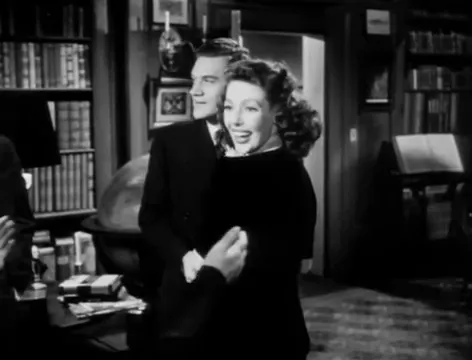
Key Scenes and Their Significance
Several sequences in The Stranger serve as keystones for its themes and aesthetics. They include:
- The bus station and suitcase—an instance of noir’s fetish for small clues that expand into existential danger.
- Meinike’s arrival and his meeting with Kindler—this is the failing rendezvous that sets the pursuit in motion.
- The church clock and automata—the symbolic heart of the film where fate, ritual, and mechanized cruelty converge.
- Wilson showing Mary footage of concentration camps—a radical use of documentary evidence to break denial.
- The dog Red’s discovery and poisoning—an emotional and narrative pivot that externalizes the danger to innocent life.
- The belfry climax—where cinematic spectacle, symbolic retribution, and moral consequence coalesce.
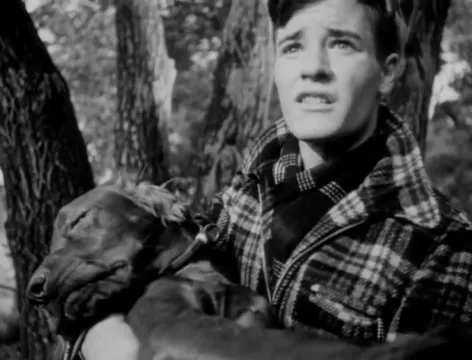
Wilson’s Ethical Strategy
Wilson’s method is both pragmatic and moral. He leverages facts, eyewitness memory, and documentary testimony to produce a cumulative case. He recognizes that legal systems require proof, and that emotional conviction is not enough. This makes him a model of investigative patience rather than brute force. Yet the film also acknowledges the limits of such methods: evidence must be gathered while the fugitive still moves freely, and truth-telling depends on the fragile courage of individuals like Mary.
The Stranger and the Film Noir Movie Tradition
As a film noir movie, The Stranger is atypical in its explicit moral program. Noir often revels in moral ambiguity, cynical narrators, and self-destructive protagonists; The Stranger preserves noir’s shadowed aesthetics and suspense rhythms while using them to expose clear moral crimes. It borrows noir devices—stark close-ups, tracking shots through quiet town spaces, and thematic motifs of identity and disguise—yet it channels them into an argument about responsibility, legal reform, and the need for public recognition of atrocity.
Its hybrid nature makes it an informative study in how noir aesthetics can serve ethical narratives. Where many noirs end in cynicism or tragedy, The Stranger offers a constricted but determinate kind of justice: the fugitive is unmasked, and though the end is violent, it feels proportionate to the scale of the crimes dramatized. The film thereby expands the film noir movie's range to include civic admonition.
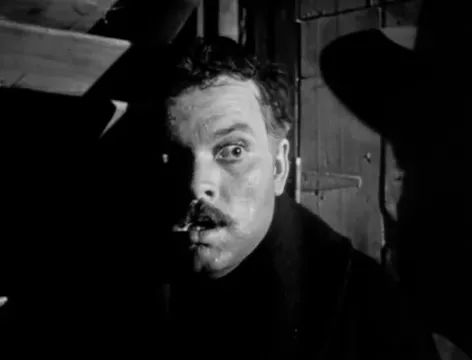
Production Constraints and Welles's Direction
Welles’s participation in the film occurred under complex circumstances. He accepted a disadvantageous contract to demonstrate he could deliver a film on schedule and under budget. Producer Sam Spiegel (as S. P. Eagle) and editor Ernest J. Nims had considerable say in the film’s final shape. Nims was authorized to cut anything not advancing the story; Welles later remarked on the tension between his stylistic tendencies and studio economy, a friction audible in the film’s lean storytelling and suppressed ornamentation. Yet Welles’s imprint remains unmistakable in the film’s moral intensity and in the daring inclusion of documentary footage.
The production’s constraints likely contributed to the film’s clarity. A tighter budget and an editor tasked with ruthlessness can yield a disciplined narrative. The Stranger benefits from this discipline: it is efficient, morally focused, and narratively direct—qualities that serve a film noir movie with didactic ambitions.
Why The Stranger Still Matters
The Stranger endures because it bridges genres and historical urgency. It is a suspenseful film noir movie that does not merely shock but attempts to instruct; it translates postwar anxieties into cinematic form, demanding that viewers confront uncomfortable truths. Its early use of Holocaust footage makes it an artifact of cultural memory—one of the first cinematic acts to insist that the American public acknowledge what had occurred in Europe.
Moreover, the film engages perennial questions about how societies identify and punish perpetrators when they hide in plain sight. Its ethical insistence—that ordinary communities must be vigilant and that justice requires persistent work—remains relevant. As contemporary audiences revisit the film, they find in it both a period piece and an urgent moral drama whose themes remain provocatively contemporary.
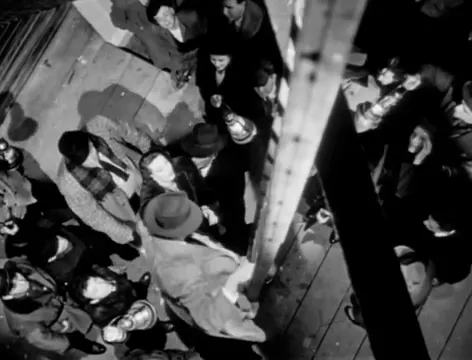
Conclusion: The Stranger as a Film Noir Movie of Conscience
The Stranger is a remarkable film noir movie precisely because it refuses to be content with stylistic bravura alone. It is a hybrid: a procedural, a moral drama, and a chamber thriller. Within its tight 95-minute running time, it stages a broad ethical canvas: the pursuit of justice against the machinery of atrocity, the fragility of memory, and the danger that ordinary respectability can harbor monstrous intent.
Orson Welles, Edward G. Robinson, and Loretta Young deliver performances shaped by the film’s need for veracity and moral weight. The production’s limitations—studio oversight, a demanding editor, and contractual strictures—paradoxically sharpened the film’s focus. The inclusion of real concentration camp footage renders the film historically significant and ethically uncompromising. The clock motif, the small-town mise-en-scène, and the decisive belfry climax together make The Stranger both a gripping film noir movie and a serious moral inquiry.
For students of classic cinema, the film rewards repeated viewings. It demonstrates how genre conventions can be marshaled in the service of urgent moral questions and how a film noir movie can be at once entertaining and ethically serious. The Stranger remains a vivid, sometimes unsettling example of cinema’s capacity to interrogate history, identity, and responsibility.
Selected Further Viewing and Reading
- Watch other Orson Welles films to compare stylistic and thematic continuities.
- Study postwar films that engage with wartime memory and accountability.
- Read historical accounts of the postwar pursuit of war criminals to situate the film in its legal and moral context.
In the final analysis, The Stranger is best approached as a film noir movie that demands attention not only for its narrative cunning but for its moral courage. It stands as a testament to what classical Hollywood could achieve when genre form and social conscience collided.
